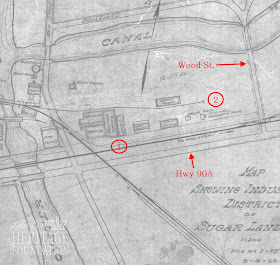The Sugar Land Heritage Foundation has a remarkably good collection of old maps. I've looked at a few recently, including this one showing the town as it was on August 8, 1925. At least, that's the date on the map.
An aside: I'm not at all happy with the way Google handles large images. I've wasted time trying to find an alternative, but have had no luck so far. So, I'll just work with what I've got until I can find something better. (On the positive side, Google's tools are free, but maybe you get what you pay for.)
The first image shows the old map in its entirety. Unfortunately, Google doesn't provide a suitable method for showing it in high resolution, so the second image shows the areas where I've magnified portions of it.
The next image shows a Google Earthview of the same general location today with annotations of the magnified areas.
Here is the first magnified zone. It shows the western edge of the town in 1928. Notation #1 shows Sugar Land's dairy, which included a barn and a 'milk house.' Notation #2 indicates a 'hay barn,' which I assume was part of the dairy. If you look closely you can see a bridge over Oyster Creek, not far from the one for modern Imperial Blvd. The dairy's cows walked over that bridge to graze in the pasture that is now home to Constellation Field and the new Imperial subdivision. Notation #3 shows the bulk fuel station. I never knew it was in operation as early as 1928.
Notation #4 shows the lumberyard. (I recently posted a photo of Hugh Charleton standing in front of that building at the time of his retirement in the 1960s.) Notation #5 is labeled 'work shop,' but I always heard it referred to as the 'labor office.' I didn't know till much later that there was an apartment in the 2nd floor of that building. Nation #6 shows the cotton gin, and as you can see from Notation #7, Visco (eventually Nalco) didn't exist in 1928. According to company history in began in the early 1930s. I've seen a photo of the original shed where it all begin. I wonder if it was the one labeled 'cake house.' The one labeled 'potato house' is too large.
The next magnified zone shows the refinery complex, but the first thing to note (#1) is the building labeled 'new sugar house & cane mill.' It shows Imperial's last raw sugar mill, which closed in 1928. Although it is 'new' per this map, I think it was actually built by Edward Cunningham in the 1880s or '90s. I believe the building labeled 'wash plant & melter' (near # 5) was an older sugar mill (later repurposed for other uses), but Leon Anhaiser (and others) may have more certain info on this question.
The image immediately below shows the last cane crop processed at this mill in 1928. The camera was pointed east at the spot where I've put Notation #1. Annotation #2 shows the 3-Bay Warehouse which still stands and will be part of Imperial Market. The structure labeled 'old warehouse' was actually the Packing Department (I think). That building and everything to the east of it has been demolished, as you can see in the Google Earthview. Notice #3 indicating the 'feed mill.' I always thought it was near the cotton gin, but this map shows it was located where the Distribution Warehouse stood, which was recently demolished but still visible in the Google Earthview image. Notation #4 shows the 'cooperage,' or barrel-making/repair shop. I assume Imperial still shipped sugar in wooden barrels in 1928. It certainly did in the very early years.
Annotation #5 identifies the Char House (constructed in 1925) and W. T. Eldridge's old home beside it. Eldridge moved to his last home on Lakeview in 1928 - it is labeled as a 'restaurant' on this map. Notice at #5 that the back of the Mercantile Store housed the railroad office. The bakery had a separate oven, as shown at #6, and the barbershop was in the same building as the bakery.
The 'meat market,' 'tailor shop,' and 'shoe repair' are near #7, as is the depot. Across Highway 90A (which is labeled Highway No. 3) at #9 is the service station and mule shed.
As #8 indicates, the Sealy Mattress Factory was gone and the building housed a 'fig factory.' The fig business was a serious disaster for Sugarland Industries not too many years later.
The east side of town appears in the last magnified image. Notation #1 shows the Salvage Building, which housed multiple departments, but notice the 'printing plant.' It printed the Texas Commercial News, Sugar Land's local paper which I've mentioned frequently. The area around #2 shows a 'hemp plant,' which I assume made bags, and two other buildings for servicing trucks (I think.) The old John Deere maintenance building hadn't been built in 1928.
One last item: notice the erasure just north of the Salvage Building. I think someone removed traces of the old Sugar Land Railway yard: the maintenance shed, roundhouse, and sidings.
We have numerous photos that supplement this map. I'll post some of them in the future and use this map to orient what they show of Sugar Land's past.







No comments:
Post a Comment